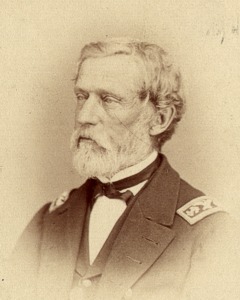

RAdm. George Foster Emmons.
In 1838–42, he participated in Captain Charles Wilkes’ Exploring Expedition, which discovered the Antarctic Continent and explored many of the islands in the southern hemisphere. In February 1841, he was promoted lieutenant. In July, after his ship Peacock grounded on Oregon’s Columbia River Bar and broke up, he led an exploration party overland to San Francisco.
During the Mexican War, Emmons served in several ships including Ohio and Warren and took part in land engagements in California. In 1953, as a lieutenant he authored The Navy of the United States from 1775 to 1853. Promoted commander in 1856, he commanded frigate Savannah in the Brazil Squadron.
During the Civil War, he first commanded side-wheel steamer Hatteras and later the R. R. Cuyler of the West Gulf Blockading Squadron. In Hatteras, blockading Florida’s Cedar Keys in January 1862, he captured a Confederate battery and destroyed six ships. At Pass Christian, Mississippi in April and along the Louisiana coast into July, he destroyed or captured about 20 more.
Promoted captain in February 1863, Emmons served as fleet captain off Charleston in Admiral Dahlgren’s South Atlantic Blockading Squadron flagship Philadelphia from August to November 1864. He then returned to the West Gulf Blockading Squadron to assume command of the second division. The surgeon of his flagship, the screw sloop-of-war Lackawanna, described him as “an officer of the old school, and while scrupulously polite to all hands and the kindest-hearted commander in the squadron to his men, old ‘Pop Emmons’, as they affectionately called him, rigidly enforced every detail of regulation regarding all points of etiquette, uniform, etc.” In December into the following spring, Capt. Emmons reported the capture or destruction another 20 blockade runners and in April, participated in perhaps the last naval action of the war—the attempted escape of the ram William H. Webb.
After the Civil War, Capt. Emmons commanded Ossipee in transporting US commissioners to Alaska, landing at Sitka on 18 October 1867 and hoisting the American flag over that part of the continent for the first time.
As Commodore Emmons from September 1868, he was appointed senior member of the Ordnance Board in Washington in 1869 and given charge of the Hydrographic Office in 1870. Promoted rear admiral in November 1872, he served as commandant of the Philadelphia Navy Yard until retiring in 1873.
Rear Admiral Emmons died at Princeton, New Jersey, 23 July 1884.
Source: Naval Historical Center DANFS History , Virtual American Biographies and Vermont in the Civil War.